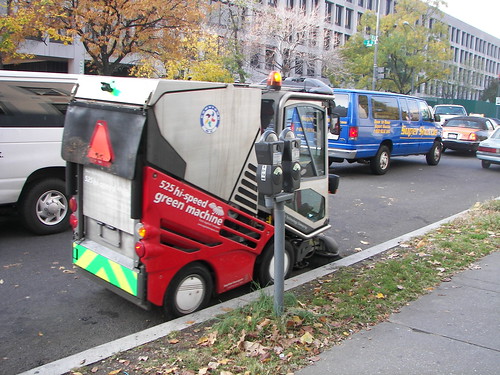Business improvement districts are not necessarily the automatic improvement mechanism people think that they are
There are at least 4 or 5 things that should be going on with a business improvement district or a Main Street commercial district revitalization program:
1. Funding;
2. Maintenance of the physical environment

Cleaning machine, D Street NW, operated by the Downtown DC Business Improvement District (BID)
3. Marketing the commercial district (and planning more generally for improvements in the District);
4. Attracting new businesses;
5. Helping current businesses function better.
Generally, business improvement districts operate in larger commercial districts and they are driven by the interests of property owners, more so than they are driven by the interests of retail businesses. Main Street commercial district revitalization programs tend to be driven by resident and merchant interest.
BIDs focus on clean and safe and some marketing, and attraction of chain retailers.
What people associate with "business improvement districts" is a particular funding system, a property value and tax based assessment system.
Main Street programs don't have access, typically, to this kind of funding stream. So for the most part, they remain penny ante organizations, despite the compelling need.
That's the real problem.
In San Diego they have plenty of business improvement districts, but most are set up either as Main Street programs, or they use the more broadly defined Main Street approach to guide their efforts. Examples include North Park Main Street, Adams Avenue Business Association, and the Little Italy Association.
These organizations sponsor a variety of activities within their geographies that with the exception of Adams Morgan Day in DC, exceed the reach of all the local commercial district revitalization programs in DC. The key difference is that the San Diego organizations have a regularized funding stream (+ the Main Street approach) and the similar organizations in DC do not.
A straight up BID is probably less successful in an emerging commercial district like Anacostia, because BIDs are set up to work in areas that need coordinated management, but are more developed, have more money, more organizational capacity, and more opportunity to improve more quickly.
In short, while I think that providing regularized funding for commercial district revitalization in Anacostia is absolutely necessary, I am not sure a straight up typical business improvement district, the way such districts work in DC, is the way to do it.
I think the best way, at least in DC, for commercial districts outside of the core of the city is the San Diego method--where you have a regularized funding mechanism combined with the Main Street approach serving merchants, rather than property owners.
See "Some Anacostia businesses face new tax for new services" from the Examiner.
Resources
-- National Main Street Center
-- International Downtown Association
-- "MAIN STREET NICHES IN A MASS SALES WORLD" (1/11/04) column by Neal Peirce
-- Business Improvement Districts and Innovative Service Delivery
Labels: commercial district revitalization, economic development, property tax assessment methodologies, public finance



0 Comments:
Post a Comment
<< Home